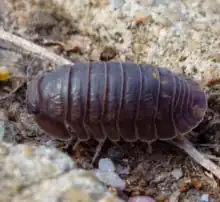Cubaris
Cubaris is a genus of woodlice in the family Armadillidae. There are more than 100 described species in the Cubaris genus.[1][2][3]
| Cubaris | |
|---|---|
 | |
| Cubaris murina | |
| Scientific classification | |
| Domain: | Eukaryota |
| Kingdom: | Animalia |
| Phylum: | Arthropoda |
| Class: | Malacostraca |
| Superorder: | Peracarida |
| Order: | Isopoda |
| Suborder: | Oniscidea |
| Family: | Armadillidae |
| Genus: | Cubaris Brandt, 1833 |
| Type species | |
| Cubaris murina | |
| Diversity | |
| at least 100 species | |
Behavior and Reproduction
Cubaris species have in average lower reproduction rates and higher lifespans than other genera of isopod.
Members of the Cubaris genus is well known for their ability to conglobate; or roll up into a ball.
Classification
Cubaris was coined in 1833, from the type species Cubaris murina.[4] In 1935, the genus Nesodillo was considered a synonym of Cubaris. Only in 1998 was Nesodillo re-established as a separate genus. The two genera still cause confusion when it comes to identification and classification,[5] and there are likely species in each genus that belong in the other. Cubaris pronyensis, Cubaris plastica, Cubaris incisa, and Cubaris pacifica are a few examples of Cubaris species which were placed in Nesodillo at some point.[6]
In recent years Cubaris has become a wastebasket taxon, resulting in many species being placed in the genus even when they do not necessarily fit the original description. This has resulted in Cubaris becoming a vague genus that often strays from the correct description. Researchers have recommended a comprehensive revision of the genus.[6]
As pets
Isopods that are considered part of the Cubaris genus are often fairly high demand within the pet isopod hobby. Many of the Cubaris species within the hobby are either undescribed or unidentified, and are referred to as "Cubaris sp.", though some have ended up being moved to other genera. One example of this is Nesodillo arcangelii, which was incorrectly identified as "Cubaris sp."
The hobby has expanded quickly in recent years, with much of the credit going to Cubaris sp. "Rubber Ducky". This undescribed Cubaris species garnered significant online attention, due to its face resembling that of a rubber ducky. A number of isopod keepers credit this 'rubber ducky isopod' for getting them into the hobby.[7]
See also
References
- "Cubaris Report". Integrated Taxonomic Information System. Retrieved 2019-09-19.
- "Cubaris". GBIF. Retrieved 2019-09-19.
- "Cubaris genus Information". BugGuide.net. Retrieved 2019-09-19.
- Moskovskoe obshchestvo liubitelei prirody.; prirody, Moskovskoe obshchestvo liubitelei (1832). Bulletin de la Société impériale des naturalistes de Moscou. Vol. t.5-6 (1832-1833). Moscou: Société impériale des naturalistes de Moscou.
- Jeon, Dae-Soo; Kwon, Do-Heon (2009). "Two New Species of the Genus Nesodillo (Isopoda, Oniscidea, Armadillidae) from Philippines". Animal Systematics, Evolution and Diversity. 25 (2): 189–195. doi:10.5635/KJSZ.2009.25.2.189. ISSN 2234-6953.
- Lillemets, Birgitta; Wilson, George D. F. (2002-06-01). "Armadillidae (Crustacea: Isopoda) from Lord Howe Island: new taxa and biogeography". Records of the Australian Museum. 54 (1): 71–98. doi:10.3853/j.0067-1975.54.2002.1360. ISSN 0067-1975.
- ChengCorrespondent, Ian (2023-06-23). "'They're not insects!': Isopods grow in popularity as pets in Singapore". The Straits Times. ISSN 0585-3923. Retrieved 2023-09-25.